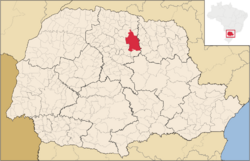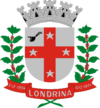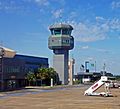Londrina facts for kids
Quick facts for kids
Londrina
|
|||
|---|---|---|---|
|
Municipality
|
|||
| Municipality of Londrina | |||
|
Clockwise from top: panorama of Londrina and the Igapó Lake; Museum of Londrina; Tomi Nakagawa Square; Igapó Lake; greenhouse of the Botanic Garden of Londrina; and Cathedral of Londrina
|
|||
|
|||
| Nickname(s):
Pequena Londres ("Little London") / Capital do Café ("Coffee Capital")
|
|||

Location in Paraná
|
|||
| Country | |||
| State | |||
| Mesoregion | Norte Central Paranaense | ||
| Microregion | Londrina | ||
| Founded | 10 December 1934 | ||
| Area | |||
| • Municipality | 1,650.809 km2 (637 sq mi) | ||
| • Metro | 4,194.9 km2 (1,619.7 sq mi) | ||
| Elevation | 610 m (2,000 ft) | ||
| Population
(2022)
|
|||
| • Municipality | 555,965 | ||
| • Density | 336.7834/km2 (872.8/sq mi) | ||
| Demonym(s) | Londrinense | ||
| Time zone | UTC-3 (BRT) | ||
| Postal Code |
86000-000
|
||
| Area code(s) | +55 43 | ||
| HDI (2010) | 0.778 – high | ||
| Major airport | Londrina Airport | ||
Londrina is a big city in the north of Paraná, a state in southern Brazil. It's about 369 kilometers (229 miles) from Curitiba, the state capital. Londrina is the second largest city in Paraná and the fourth largest in southern Brazil. In 2022, about 555,965 people lived there.
The city's name, Londrina, means "Little London." This name was chosen to honor the British people who first explored the area. Londrina was officially started in 1930 by groups of Italian, Japanese, and German settlers. It quickly grew into an important center for business, politics, and culture in the northern part of the state. The city is also home to major universities like the State University of Londrina (UEL).
Contents
- Discovering Londrina: A City's Story
- Londrina's Location and Weather
- Londrina's Economy: How the City Makes Money
- Learning in Londrina: Schools and Universities
- Londrina's Greater Area: The Metropolitan Region
- Faith and Community in Londrina
- Sports in Londrina: Football and Basketball
- Famous People from Londrina
- Londrina's Sister Cities Around the World
- Images for kids
- See also
Discovering Londrina: A City's Story
Londrina got its name from British business people. They built railroad stations in the area. These stations helped transport coffee beans from northern Paraná and southern São Paulo to the port of Santos. The name Londrina is a tribute to London, the capital of Britain. A British cotton company, Paraná Plantations Limited, invested money to help settle this area.
| Historical population | ||
|---|---|---|
| Year | Pop. | ±% |
| 1900 | 509 | — |
| 1910 | 976 | +91.7% |
| 1920 | 1,483 | +51.9% |
| 1930 | 27,475 | +1752.7% |
| 1940 | 65,889 | +139.8% |
| 1950 | 71,321 | +8.2% |
| 1960 | 136,401 | +91.2% |
| 1970 | 347,544 | +154.8% |
| 1980 | 403,005 | +16.0% |
| 1990 | 385,580 | −4.3% |
| 2000 | 447,065 | +15.9% |
| 2009 | 510,707 | +14.2% |
| 2010 | 506,645 | −0.8% |
| 2011 | 511,278 | +0.9% |
| 2012 | 515,707 | +0.9% |
| 2013 | 537,566 | +4.2% |
| 2014 | 543,003 | +1.0% |
| 2022 | 555,965 | +2.4% |
Londrina's Location and Weather
Londrina is located in the northern part of the state of Paraná. It is about 369 kilometers (229 miles) away from Curitiba, the state capital.
What is Londrina's Climate Like?
Londrina has a humid subtropical climate. This means it has warm, wet summers and mild winters. The climate is influenced by the Atlantic Forest biome, which is a type of forest.
The city gets about 1,622.6 millimeters (63.9 inches) of rain each year. The average yearly temperature is about 20.62 degrees Celsius (69.1 degrees Fahrenheit).
| Climate data for Londrina (1981–2010) | |||||||||||||
|---|---|---|---|---|---|---|---|---|---|---|---|---|---|
| Month | Jan | Feb | Mar | Apr | May | Jun | Jul | Aug | Sep | Oct | Nov | Dec | Year |
| Record high °C (°F) | 37.3 (99.1) |
37.5 (99.5) |
36.7 (98.1) |
34.9 (94.8) |
32.0 (89.6) |
31.0 (87.8) |
31.3 (88.3) |
33.3 (91.9) |
39.4 (102.9) |
40.0 (104.0) |
39.0 (102.2) |
39.3 (102.7) |
40.0 (104.0) |
| Mean daily maximum °C (°F) | 30.0 (86.0) |
30.3 (86.5) |
30.8 (87.4) |
28.6 (83.5) |
24.9 (76.8) |
23.8 (74.8) |
24.2 (75.6) |
26.6 (79.9) |
27.6 (81.7) |
29.1 (84.4) |
30.2 (86.4) |
30.1 (86.2) |
28.0 (82.4) |
| Daily mean °C (°F) | 24.5 (76.1) |
24.4 (75.9) |
24.1 (75.4) |
22.3 (72.1) |
18.7 (65.7) |
17.3 (63.1) |
17.2 (63.0) |
19.2 (66.6) |
20.6 (69.1) |
22.6 (72.7) |
23.8 (74.8) |
24.2 (75.6) |
21.6 (70.9) |
| Mean daily minimum °C (°F) | 20.2 (68.4) |
20.1 (68.2) |
19.2 (66.6) |
17.3 (63.1) |
13.8 (56.8) |
12.3 (54.1) |
11.7 (53.1) |
13.1 (55.6) |
14.8 (58.6) |
17.2 (63.0) |
18.5 (65.3) |
19.5 (67.1) |
16.5 (61.7) |
| Record low °C (°F) | 12.0 (53.6) |
13.0 (55.4) |
8.2 (46.8) |
4.8 (40.6) |
0.0 (32.0) |
−2.8 (27.0) |
−0.5 (31.1) |
0.3 (32.5) |
3.0 (37.4) |
7.6 (45.7) |
8.8 (47.8) |
11.3 (52.3) |
−2.8 (27.0) |
| Average precipitation mm (inches) | 243.2 (9.57) |
179.8 (7.08) |
134.9 (5.31) |
94.3 (3.71) |
109.7 (4.32) |
86.4 (3.40) |
66.1 (2.60) |
54.3 (2.14) |
102.6 (4.04) |
139.7 (5.50) |
150.9 (5.94) |
221.1 (8.70) |
1,583 (62.32) |
| Average precipitation days (≥ 1.0 mm) | 15 | 12 | 9 | 7 | 8 | 5 | 5 | 4 | 7 | 9 | 9 | 12 | 102 |
| Average relative humidity (%) | 78.1 | 76.3 | 74.3 | 75.4 | 78.3 | 79.5 | 74.8 | 68.6 | 67.8 | 69.7 | 70.4 | 73.8 | 73.9 |
| Mean monthly sunshine hours | 185.0 | 192.3 | 224.4 | 212.7 | 191.5 | 198.0 | 202.4 | 218.7 | 187.7 | 199.4 | 209.1 | 198.5 | 2,419.7 |
| Source: Instituto Nacional de Meteorologia | |||||||||||||
Londrina's Economy: How the City Makes Money
Agriculture is still a very important part of Londrina's economy. Even though it's not as big as it used to be, farming still brings a lot of money to the city. Farmers grow many different crops besides coffee. These include corn, wheat, cotton, beans, peanuts, rice, sugar cane, and soy bean. They also grow fruits and vegetables. The soil in this region, called "terra roxa/vermelha" (crimson soil), is very rich and helps these crops grow well.
Londrina has also grown its industrial areas. There are factories that make fabrics, textiles, and agricultural products. But farming is still a main source of wealth. Today, Londrina is also known for its many shops and services. The real estate business is also growing, creating more jobs and helping the city expand.
The city has one of the largest universities in Brazil, the State University of Londrina. It also has several private colleges. Londrina is served by the Londrina – Governador José Richa Airport.
Once a year, Londrina hosts Expo Londrina. This is the biggest agricultural fair in Latin America.
Learning in Londrina: Schools and Universities
Portuguese is the main language spoken in Brazil. It is also the main language taught in schools in Londrina. However, English and Spanish are also part of the official high school lessons.
In 2010, almost all children (97.3%) between 6 and 14 years old were in school. In 2018, about 65,065 students were in basic education. Another 18,140 students were in middle and high school.
Colleges and Universities in Londrina
Londrina is home to many colleges and universities. These schools offer a wide range of subjects for students to study.
- Universidade Estadual de Londrina (UEL) – "Londrina State University"
- Universidade Tecnológica Federal do Paraná (UTFPR) – "Federal University of Technology – Paraná"
- Pontifícia Universidade Católica do Paraná (PUC-PR) – "Pontifical Catholic University of Paraná"
- Universidade Norte do Paraná (UNOPAR) – "North Paraná University"
- Centro Universitário Filadéfia (UniFil) – "Filadélfia University Center"
- Faculdade Pitágoras – "Pitágoras College"
- Faculdade Arthur Thomas (FAAT) – "Arthur Thomas College"
- Faculdade Teologica Sul Americana (FTSA) – "South American Theological College"
Londrina's Greater Area: The Metropolitan Region
The Metropolitan Region of Londrina was created in 1998. It includes Londrina and several nearby cities. These cities are Cambé, Ibiporã, Sertanópolis, Bela Vista do Paraíso, Jataizinho, Rolândia, Tamarana, and Arapongas. Together, these cities have about 750,000 people living in them.
Faith and Community in Londrina
Londrina is an important center for different religions. It is the main city for the Roman Catholic Archdiocese of Londrina. This means it's a key place for the Catholic Church in the region.
The city also has two stakes (large groups of congregations) of the Church of Jesus Christ of Latter-day Saints. It is also the main office for the Brazil Londrina Mission. This mission covers northern Paraná and parts of São Paulo.
Sports in Londrina: Football and Basketball
Londrina is a city that loves sports! It has two main football (soccer) clubs. These are Londrina Esporte Clube, started in 1956, and the Associação Portuguesa Londrinense, started in 1950. Both teams play their games at the Café stadium. This stadium can hold up to 45,000 fans!
The city also has a major basketball club called Inesul/Londrina. This team is owned by INESUL, a higher education school. They play in the Campeonato Brasileiro de Basquete, which is a big basketball league in Brazil.
Famous People from Londrina
Many talented people have come from Londrina. Here are some of them:
- Michelle Alves, a model
- Giovane Élber, a famous footballer
- Fernandinho, another well-known footballer
- Giba, a volleyball player who won Olympic and World championships
- Bruno Henrique, a footballer
- João Victor Horto, a racing driver
- Jádson, a footballer
- Victor Lazzarini, a composer
- Everson Maciel, a footballer
- Marcão, a footballer
- Naldo, a footballer
- Elisângela Oliveira, an Olympic medal-winning volleyball player
- Flávia de Oliveira, a model
- Rafinha, a footballer
- Rogério Romero, a swimmer
- Pedro Rezende, a popular YouTuber
- Rafael Santos, a footballer
- Dionatan Teixeira, a footballer
- Douglas Vieira, a judoka who won an Olympic silver medal
- Diogo Yabe, a swimmer
Londrina's Sister Cities Around the World
Londrina has "sister city" relationships with several cities in different countries. These partnerships help promote cultural exchange and friendship.
 Toledo, United States
Toledo, United States Zhenjiang, China
Zhenjiang, China
Images for kids
See also
 In Spanish: Londrina para niños
In Spanish: Londrina para niños















